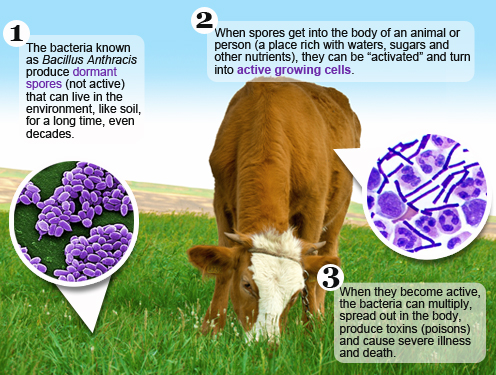Introduction
This is an acute and highly contagious lungs and intestinal tract bacterial infection.
This is commonly spread from animals like cows, goats, and sheep. The bacterial is a spore-forming bacterium which can live in the soil and animal products for decades. This infection is potentially fatal.
Causative organism: Bacillus Anthracis
Mode of transmission
- Through direct contact with tissues of animals dying from the disease or direct contact with contaminated hair, wool and soil. This causes cutaneous anthrax.
- Through inhalation of spore of the organism causing pulmonary anthrax.
- Gastro-intestinal
anthrax: transmitted through eating contaminated meat from infected mammals especially
infected dead animals. This gastro-intestinal anthrax is difficult to recognize.

Photo by CDC
These categories of people are considered to be of high risk;
- Veterinary officers.
- Labouratory Technicians.
- Employers of textile Companies.
- Fulani herds men.
Signs and Symptoms
- Itching of the affected skin.
- Lesion develops leading to black scab (eschar).
- Regional lymphadenopathy.
- Oedema around the slough.
- Pulmonary anthrax: resemble common cold i.e. fever, headaches, cough etc.
- Acute Symptoms of respiratory distress, shock and then death.
- Sudden and general malaise.
- Septicaemia, followed by death.
Management
- Penicillin injection or oral tetracycline or erythromycin.
- Pulmonary anthrax is treated with intravenous penicillin.
- Corticosteroids e.g. dexamethasone may be given for skin itching or lung inflammation.
- If treatment is delayed because diagnosis is not made promptly, death is likely.
Prevention and Control
- All infected persons must be treated promptly and effectively.
- Proper disposal of discharge from lesion or soiled articles.
- Prompt isolation and treatment of animals suspected of anthrax.
- Consumption of dead animals should be avoided.
- Vaccination of all animals annually.
- Proper cooking of meat before eating.
- All animals should be examined before and after slaughtering and selling to the public.
- Proper washing, disinfection of hair wool and hides before processing for sale.
- Health education on cause, mode of transmission, signs and Symptoms as well as how to prevent the disease.
- Notification of the disease to the health authority.
Read Also








0 Comments